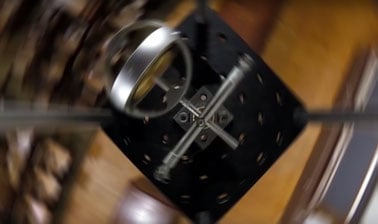The online vertical motion simulations on this page show us different situations in which we can verify the application of the laws of physics in jumps and falls. We will discover how is the physics of the high and how are the forces and energy balance in a fall
What is vertical motion
Vertical motion is that in which an object moves along a straight, upward or downward trajectory, perpendicular to the ground, i.e. along the vertical axis. This type of motion is mainly influenced by gravity, which constantly pulls bodies towards the center of the Earth. In ideal situations, such as in a vacuum, vertical motion can be analyzed without considering air resistance, which facilitates the application of equations and physical principles to predict the behavior of rising or falling objects. Thus, the study of vertical motion is essential to understand phenomena such as jumps, launches and free falls, and allows the calculation of variables such as velocity, flight time and the maximum height reached by a body.
Jumps
When a person performs a jump, a downward force is applied against the ground to generate a reaction and propel him or her upward. During the jump, the kinetic energy of the body is converted into gravitational potential energy as it rises into the air. At the highest point of the jump, the potential energy is maximum and the kinetic energy is minimum. As the body falls downward, the potential energy is converted back to kinetic energy, and the body accelerates toward the ground under the action of gravity.
Free fall
Free fall is a type of motion that occurs when an object is under the influence of gravity alone, with no other force – such as air resistance or an initial push – acting on it. Under these conditions, all bodies, regardless of their mass, accelerate towards the ground with the same speed. This phenomenon allows us to analyze the behavior of objects in vertical motion and is fundamental for understanding concepts such as gravitational acceleration, kinetic and potential energy, as well as the formulation of equations that predict the distance and time of fall.
According to Newton’s law of universal gravitation, the acceleration of an object in free fall is constant and is called acceleration due to gravity. On Earth, this acceleration approaches 9.8 m/s². The distance an object falls in a given time can be calculated using the equation for free fall:
d = 1/2 g t²,
where
d is the distance
g is the acceleration due to gravity
t is the time.
In addition to gravity, other factors can influence jumps and falls, such as air resistance, the shape of the object and applied external forces. These factors can modify the behavior of the moving object and affect its trajectory, velocity and time of fall.
Importance and applications of vertical motion
The study of vertical motion is essential because it allows us to understand everyday and natural phenomena, as well as to lay the foundations for analyzing and solving problems in physics and various branches of science and engineering. Knowing how an object falls or how it behaves when thrown vertically facilitates the prediction of trajectories, times and velocities, which is fundamental both in experimental research and in the design of technological devices.
Among the best-known applications of vertical motion are laboratory experiments to determine local gravitational acceleration, the development of instruments such as parachutes and the planning of sports where jumps and falls are key elements, such as athletics or gymnastics. In addition, understanding these concepts is useful in many areas of engineering, for example, in calculating trajectories of falling objects from elevated structures, or in accurately calculating the trajectories of aerospace devices.
These online vertical motion simulations are very useful to understand the physical laws behind jumps and falls and the transformation between kinetic and potential energy that occurs.
Explore the exciting STEM world with our free, online simulations and accompanying companion courses! With them you'll be able to experience and learn hands-on. Take this opportunity to immerse yourself in virtual experiences while advancing your education - awaken your scientific curiosity and discover all that the STEM world has to offer!
Vertical motion simulations
- Analysis
- Experiment I
- Experiment II
- Horizontal
Free fall motion analysis
Observe in this free fall simulation how two objects with different masses fall, which one will fall faster?
Free fall experiment I
This free fall simulation allows us to analyze how height affects the speed of the fall. Place the ball at different heights and observe the final fall speed. Can you explain why? Do you know how to calculate it?
Free fall experiment II
This new free fall simulation allows us to analyze in more detail what is the value of the velocity of a free falling object. Adjust the height of the sensors, observe the velocity and look for an explanation.
Horizontal drop
Observe in this simulation how an object falls when it is thrown with a horizontal velocity. What kind of trajectory does it describe? why?
- Parachute
- Bungee I
- Bungee II
Parachute and terminal velocity
This animation reproduces what it is like to jump with a parachute. Observe what happens to the speed before and after opening the parachute. Can you explain what forces act in each case?
“Bungee jumping” without loss of energy
This simulation represents the jump of a person held by an elastic rope without loss of energy. When the fall begins, the person’s speed accelerates until the tension of the rope holds him/her and propels him/her upwards. Observe how the Gravitational Potential Energy (GPE), Kinetic Energy (KE) and Elastic Potential Energy (EPE) vary. Why doesn’t the movement stop?
“Bungee jumping” with loss of energy
This simulation represents the jump of a person held by an elastic rope with energy loss. When the fall begins, the person’s velocity accelerates until the tension of the rope holds him/her and propels him/her upwards. Observe how the Gravitational Potential Energy (GPE), Kinetic Energy (KE) and Elastic Potential Energy (EPE) vary. Why does the motion stop?
Giants of science
“If I have seen further, it is by standing on the shoulders of giants”
Isaac Newton

William Rowan Hamilton
–

Archimedes
–
Become a giant


Mechanics, Part 2



Mechanics, Part 1



Dynamics and Control



Pre-University Physics



AP® Physics 1 – Part 4: Exam Prep



Circuits for Beginners



The Basics of Transport Phenomena
































